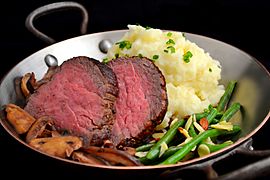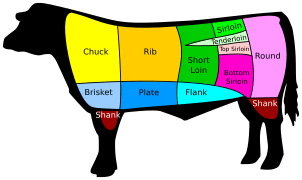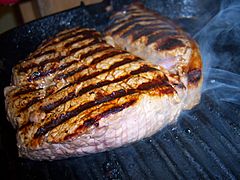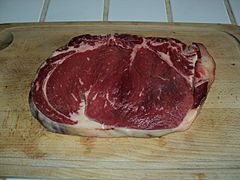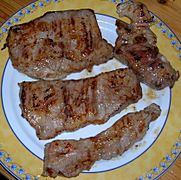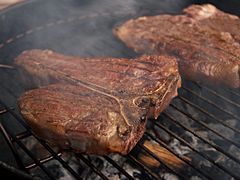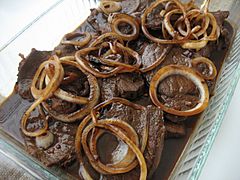Beefsteak facts for kids
A beefsteak, often called just steak, is a flat cut of beef with parallel faces, usually cut perpendicular to the muscle fibers. In common restaurant service a single serving has a raw mass ranging from 120 to 600 grams (4 to 21 oz). Beef steaks are usually grilled, pan-fried, or broiled. The more tender cuts from the loin and rib are cooked quickly, using dry heat, and served whole. Less tender cuts from the chuck or round are cooked with moist heat or are mechanically tenderized (cf. cube steak).
Contents
Regional variations
Australia
In Australia, beef steak is referred to as just "steak" and can be purchased uncooked in supermarkets, butchers, and some smallgood shops. It is sold cooked as a meal in almost every pub, bistro, or restaurant specialising in modern Australian food, and is ranked based on the quality and the cut. Most venues usually have three to seven different cuts of steak on their menu and serve it from blue to well-done according to preference. A steak is normally accompanied by a choice of sauces and a choice of either chips (thick fried potatoes) or mash potato. A complementary choice of side salad or steamed vegetables is also commonly offered.
France
In France, steak, locally called bifteck, is usually served with fried potatoes (pommes frites in French). The combination is known as steak-frites. Vegetables are not normally served with steak in this manner, but a green salad may follow or (more commonly) be served at the same time. This is also the case in Argentina. Steaks are often served with classic French sauces.
Indonesia
In Indonesia, bistik jawa is a beefsteak dish that is influenced by Dutch culinary. Another Indonesian beefsteak is selat solo with Dutch-influenced, a specialty of Surakarta, Central Java.
Italy
In Italy, steak was not widely eaten until after World War II because the relatively rugged countryside does not readily accommodate the space and resource demands of large herds of cattle. Some areas of Piedmont, Lombardy, and Tuscany, however, were renowned for the quality of their beef. Bistecca alla fiorentina is a well-known specialty of Florence; it is typically served with just a salad. From the 1960s onward, economic gains allowed more Italians to afford a red-meat diet.
Mexico
In Mexico, as well as in Spain and other former Spanish colonies, bistec (a Spanish loanword from English "beefsteak") refers to dishes of salted and peppered beef sirloin strips. One form of Mexican bistec is usually flattened with a meat tenderizing tool, covered in bread crumbs and fried. The dish is usually served in tortillas as a taco.
Spain
Spain and its former colonies have variations of bistec encebollado (beefsteak with onions). It can be found across Latin America and the Philippines in Southeast Asia.
Philippines
In the Philippines, bistek Tagalog, a specialty of the Tagalog provinces, is typically made with strips of sirloin beef and onions slowly cooked in soy sauce and calamansi juice. Unlike usual beefsteak that has different degrees of doneness, Filipino bistek is always served well done.
United Kingdom
In the United Kingdom, steak is often served with medium-thick fried potatoes (chips), fried onions, mushrooms, and tomatoes; however, in some restaurants, it is more likely to be served with potatoes and other vegetables and offered with a selection of cooked sauces such as red wine, Diane, Bordelaise, mushroom, Hollandaise, au poivre (peppercorn), or Béarnaise. Other vegetables such as peas or a green salad can also be served. Various types of mustard are sometimes offered as a condiment.
United States
In the United States, a restaurant that specializes in beef steaks is a steakhouse. The more expensive steakhouses serve the highest grades of beef and often dry-age it for many weeks. The well-aged beef cooked on high-heat grills and broilers produces a steak difficult to emulate in a home kitchen. A typical steak dinner consists of a steak, optionally topped with sautéed onions or mushrooms, with a starchy side dish; usually baked or mashed potatoes, or thick-cut fried potatoes known as steak fries. Chili, rice, pasta, or beans are also common sides. A side salad or a small serving of cooked vegetables often accompanies the meat and side, with corn on the cob, green beans, creamed spinach, asparagus, tomatoes, mushrooms, peas, and onion rings being popular. Bread is generally served, usually a dinner roll.
Steak is sometimes served with shrimp or lobster tail, giving "surf and turf" or "reef and beef".
Special steak knives are provided, which are usually serrated, though straight blades also work; they also often have wooden handles. Prepared condiments known as steak sauces are generally on the table in steakhouses. Tenderized round or sirloin steaks, breaded, and pan-fried or deep-fried, are called "chicken fried" or "country fried" steaks, respectively. An iconic specialty of Philadelphia is the Philly cheesesteak, composed of thinly sliced ribeye or other tender cuts, cooked on a hot griddle and shredded slightly, and served on Italian-style rolls with one of a few types of cheese (American, mild Provolone or "Cheez Whiz" sauce).
Special beef designations
USDA beef grades
Degree of cooking
The amount of time a steak is cooked is based upon personal preference; shorter cooking times retain more juice, whereas longer steak cooking times result in drier, tougher meat, but reduce concerns about disease. A vocabulary has evolved to describe the degree to which a steak is cooked. The following terms are in order from least cooked to most cooked:
- Raw (French: cru) – Uncooked. Used in dishes like steak tartare, carpaccio, gored gored, tiger meat and kitfo.
- Seared, blue rare or very rare (French: bleu) – Cooked very quickly; the outside is seared, but the inside is usually cool and barely cooked. The steak will be red on the inside and barely warmed. In the United States, this is also sometimes referred to as "black and blue" or "Pittsburgh rare". In Germany this is also known as "English-style or bloody". It is common for chefs to place the steak in an oven to warm the inside of the steak. This method generally means that "blue" steaks take longer to prepare than any other steak degree, as these require additional warming time prior to cooking.
- Rare (French: saignant) – (52 °C (126 °F) core temperature) The outside is grey-brown, and the middle of the steak is fully red and slightly warm.
- Medium rare (French: entre saignant et à point) – (55 °C (131 °F) core temperature) The steak will have a reddish-pink center. This is the standard degree of cooking at most steakhouses, unless specified otherwise.
- Medium (French: à point, anglais) – (63 °C (145 °F) core temperature) The middle of the steak is hot and fully pink surrounding the center. The outside is grey-brown.
- Medium well done (French: demi-anglais, entre à point et bien cuit) – (68 °C (154 °F) core temperature) The meat is lightly pink surrounding the center.
- Well done (French: bien cuit) – (73 °C (163 °F) and above core temperature) The meat is grey-brown in the center and slightly charred. In parts of England this is known as "German style".
- Overcooked (French: trop cuit) – (much more than 90 °C (194 °F) core temperature) The meat is blackened throughout and slightly crispy.
-
Degrees of cooking in various languages English French German raw cru roh blue rare, very rare bleu blau, Englisch rare saignant blutig medium rare — — medium à point, anglais medium, rosa medium well-done demi-anglais halbrosa well-done bien cuit durch (gebraten)
A style exists in some parts of North America called "Chicago". A Chicago-style steak is cooked to the desired level and then quickly charred. The diner orders it by asking for the style followed by the doneness (e.g. "Chicago-style rare"). A steak ordered "Pittsburgh rare" is rare or very rare on the inside and charred on the outside. In Pittsburgh, this style is referred to as "black and blue" (black or "sooty" on the outside, and blue rare on the inside).
Types of beef steaks
- Rib steak
- from the rib primal of a beef animal, usually with rib bone attached. In some areas, the boned version is called a "rib eye", in others the terms are interchangeable.
- Swiss steak
- a steak which has been pounded with a tenderizing hammer, or run through a set of bladed rollers to produce "cube steak". Typically made from relatively tough cuts of meat, such as the round.
Several other foods are called "steak" without actually being steaks:
Gallery
-
A T-bone steak being cooked on a grill
-
A ribeye steak meal with fries and tater tots
-
Bistek Tagalog: strips of sirloin beef slowly cooked in soy sauce, calamansi juice, and onions.
Images for kids



